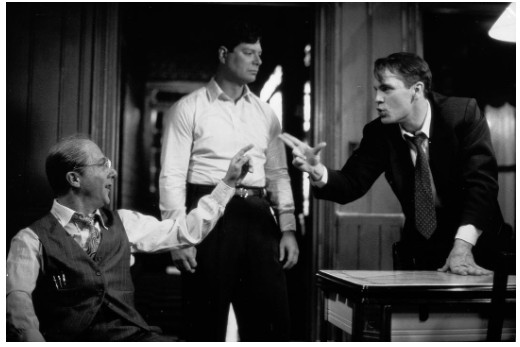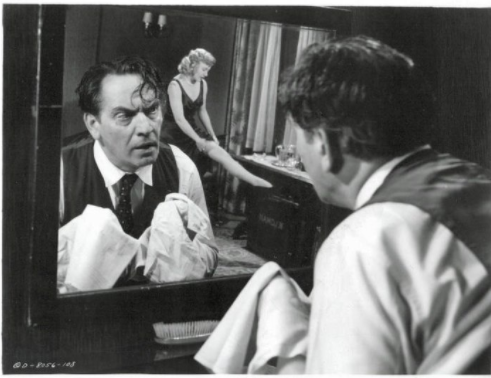Chapter One Literature Review
1.1 Research on Death of a Salesman
Since Death of a Salesman had come into being in 1949, it has long been enjoying popularity in the theater world, as Brenda Murphy observes, ―since its premiere, there has never been a time when Death of a Salesman was not being performed somewhere in the world‖ (Miller: Death of a Salesman 70). Not only has the play ever been running for at least 740 performances in theaters and a collection of revival on Broadway, but, so far, the reception of it throughout the literary circles in both China and the western countries has undergone a long-time prosperity, especially since the 1980s. Here, I‘d like to go into the literary review abroad and at home of Death of a Salesman in a general way.
1.1.1 Research Abroad
Theme research: In general, a large number of foreign critics give their first priorities to the topic research when delving into the text of Death of a Salesman. Topics on family dreams, values, and relationship are on the lists. Irving Jacobson in his article ―Family Dreams in Death of a Salesman‖ presents that what Willy Loman wants and what success means in the play is closely connected with the underlying sense of family, which can be examined in terms of four variables: transformation, prominence, synthesis, and unity (248). In addition, Leah Hadomi‘s ―Rhythm Between Fathers and Sons: Death of A Salesman‖ holds that there is a similar doubling of brother relationships between Biff and Happy and between Willy and Ben. In both relationships, the son who left arouses envy in the son who stayed (13). And Steven R. Centola is in the belief that a detailed exploring on Willy‘s values can be of great thematic significance (26) in his article ―Family Values in Death of a Salesman”.

文学地理学视域下《推销员之死》中景观表征的悲剧内涵
1.2 Relevant Theories on Literary Geography
The present thesis ―On the Tragic Connotations by Landscapes Representation in Death of a Salesman from the Perspective of Literary Geography‖, centering on Arthur Miller‘s Death of a Salesman, is going into the tragic connotations represented by landscapes in the play through literary geography theory, in an attempt to interpret Millers‘ pondering over the modern landscapes.
At the very beginning around the early 1930s, literary geography either assesses the influence of specific environment on writer‘s thoughts and writings, or examine the writer‘s perception of the landscape or region in which he/she ever lived and wrote, coupled with the reconstruction of the regional landscapes of a writer from his/her writings. Till the Second World War, scholars and critics of literary geography interpret literary works with a cultural orientation, especially focusing on the social, political and historical geography. Since the beginning of the new century, literary geography criticism has been widely applied for literature studies, but still focuses on the topics of the geographical realities either in specific writers or in their works, or on the relationship between the specific geographical space in which a writer ever lived and the one that is reflected in the writer‘s literary works in particular (Zou Jianjun & Zhou Yafen 38). Most prominently, however, is that all among the literary geography criticism mutually regard landscapes as the best representation of both subjects‘ perception and their experiences (Ren Bing 31). ―Landscape‖ means ―an area shaped by the significant connection between nature and culture‖ (R.J. Johnston 367-368), or may refer to ―a natural scene through the medium of culture, a representation as well as a presented space; a signifier as well as the signified; a frame as well as content; a real place as well as a simulative room; a package as well as packed goods‖ (W. J. T. Mitchell 5). Literary geography critics examine both natural landscapes and cultural landscapes in literary works. Among the well-known literary geography critics are Guy Debord, Mike Crang, Tuan Yi-fu, W. J. T. Mitchell, Douglas Kellner, and so on.
..............................
Chapter Two Tragic Connotations Represented by the Angular-shaped Apartment
2.1 Unreal Living State of Loman Willy
In Space and Place: The Perspective of Experience, Tuan Yi-fu undertakes the research on the critical role that architectural landscapes play in modern life, and declares that modern built environmental landscape is all the time articulating social order and maintaining a teaching function:
Its signs and posters inform and expostulate… exert a direct impact on the senses and feeling. The body responds, as it has always done, to such basic features of design as enclosure and exposure, verticality and horizontality, mass, volume, interior spaciousness, and light (Space and Place 116).
In line with this view, different architectural styles, including the vertical shapes and the horizontal ones, as Tuan asserts, can define and then reflect people‘s different beliefs and world views. Generally speaking, the vertical architecture, symbolic of transcendence, internality, detachment and constant efforts to go upward (Tuan Yi-fu, Topophilia 28), is firstly capable of arousing people‘s consciousness of desperate struggle, the angular-shaped architecture in particular, one of the sort of vertical architecture (169), which masks the harsh economic and political realities with a thick layer of bubbles (Tuan Yi-fu, Escapism 6). As a result, the distance between human nature and the real environment becomes larger and larger, giving rise to a sort of unreal living state of human beings (in which people cannot see the distance between their survival condition and the social reality).
Thus, it can be presumably concluded that Miller‘s focus on the angular-shaped apartment reflects the deterrent influence that the angular-shaped apartment exerts on the protagonists‘ living state, when Miller takes Willy Loman as a representative. Surrounded by such angular-shaped apartments, Willy is indeed prone to have an unreal living state, after all, the modern landscape is a sort of sector where all attention and all consciousness, converges, the locus of illusion and false consciousness, not a decorative element added to the real world but the very heart of society‘s real unreality (Guy Debord 12-13).
.............................
2.2 The Materialized Social Relationship
The angular-shaped architecture, symbolic of transcendence, internality, detachment and constant efforts to go upward (Topophilia 28), as argued before, has been capable of arousing Willy, along with the then American communities‘ consciousness of desperate striving. However, such a desperate striving for material consumption regardless of the reality may give rise to deterrent consequences. Tuan Yi-fu further points out that when humans do their utmost to achieve a goal, it may turn out that ―the goal attained is not the result of intentional action but rather of larger forces of which there is no prior knowledge…the one attained, for all its temporary or local advantages, has long-range, bad consequences that cannot be predicted‖ (―A View of Geography‖ 104). One of the bad consequences is embodied in the materialized social relationship, insofar as modern architecture is extremely dazzling, focusing only on the material appearance and ignoring the substantive content such as human nature and human relations. In this regard, Miller puts the angular-shaped apartment in the play under the spotlight is also to display the tragic connotations that the apartment landscape represents in terms of the materialized social relationship, given that landscapes are never a collection of visual images, rather, they ―are a complex of relationships between people that is mediated by images‖, which are ―far better viewed as a weltanschauung that has been actualized, translated into the material realm— a world view transformed into an objective force‖ (Guy Debord 12-13).
In the play, the materialized social relationship manifests itself in the materialized employment relationship between Willy and Howard in particular and the materialized peer relationship between Biff and Bernard for instance.

文学地理学视域下《推销员之死》中景观表征的悲剧内涵
.................................
Chapter Three Tragic Connotations of the One-dimensional Enclosed House ........... 40
3.1 Distorted Personality and Perception of the Lomans ..................................... 41
3.1.1 Twisting of the Lomans‘ Personality ................................... 42
3.1.2 Deprivation of the Lomans‘ Place-sense ................................ 46
Chapter Four Tragic Connotations of the Barren Backyard Garden ........................... 60
4.1 Absolute Worship of Commerce and Building Industry ............................... 61
4.1.1 Immersion in Business World ................................... 62
4.1.2 Addiction to House Construction................................ 65
Chapter Four Tragic Connotations of the Barren Backyard Garden
4.1 Absolute Worship of Commerce and Building Industry
Presumably, the barren backyard garden represents the characters‘ absolute worship of commerce and building industry, in the light of the fact that Death of a Salesman is written after the Second World War, a period when American‘s industrialization and urbanization has got great development and there is a dramatic change in American career choices: Between 1940 and 1950, the young are more interested in industry and commerce when choosing a career, inasmuch as, to some degree, the views of natural aesthetics represented by ‗garden‘ and the traditional values based on family and interpersonal relationship have been veritably replaced by the ―standardized‖ industrial civilization that modernity calls on (Shi Qingjing 97-100). Under the stimulation and influence of the angular-shaped apartment landscape and the one-dimensional enclosed house landscape, to integrate into the so-called ‗standardized‘ civilization, the Lomans, together with other characters in the play, as the very representatives of the then Americans, not only dedicate themselves to business world but also crave for man-made landscapes construction and give privilege to those ‗material goods‘ especially in the process of houses interior landscape construction.
To put in a nutshell, in the play, the absolute worship of commercial and building industry is mainly manifested as the immersion in business world and the addiction to house construction.
In the first half of the 20th century, the industrialization and urbanization of the United States have made remarkable progress, coupled with the economic development which has directly determined people‘s career preference; namely, people get enthralled with and thus immersed in commercial business. In the play, the hero Willy himself, his father, brother Ben, boss old Wagner and his friend Charley, the very representatives of the older generation, are all engaged in business or economic activities, while the younger generation like Happy, Howard and Oliver, are also fascinated by commercial business.
................................
Conclusion
The time when Arthur Miller creates Death of a Salesman is the period of the expansion of American dream. Not only has capitalism and industry gotten dramatic development, but the landscapes have infinitely expanded. Thenceforth, people adore landscapes like ants attaching themselves to what is rank and foul, giving rise to the permanent presence of landscapes especially in those capitalist countries like the United Sates, a realm having entered the stage of landscape society. Landscape in the social hierarchy is usually in a position of the social consciousness form which is capable of yielding ideology, having obvious ideological function. On the one hand, the real existence of the landscape proves and upholds the legitimacy of the capitalist system; on the other hand, people in the capitalist society are also consciously or unconsciously influenced and thus controlled by the landscape, as is shared by both of the western Literary Geography theoreticians and Chinese critics.
Nevertheless, American landscape society has always regarded capitalism and materialism as the standard in its development process. Landscape construction clearly proclaims social norms, and even plays a sort of didactic role with images representation of message and exhortation. Especially, the special architecture continues to exert a great influence on people‘s feelings and perception, the basic features of which, such as ―enclosure and exposure, verticality and horizontality, mass, volume, interior spaciousness, and light‖ (Tuan Yi-fu, Space and Place 116), etc., will, as always, interact with human‘s consciousness.
reference(omitted)
